The NVIDIA GeForce GTX 780 Ti Review
by Ryan Smith on November 7, 2013 9:01 AM ESTOverclocking
Finally, let’s spend a bit of time looking at the overclocking prospects for the GTX 780 Ti. Although GTX 780 Ti is now the fastest GK110 part, based on what we've seen with GTX 780 and GTX Titan there should still be some headroom to play with. Meanwhile there will also be the matter of memory overclocking, as 7GHz GDDR5 on a 384-bit bus presents us with a new baseline that we haven't seen before.
| GeForce GTX 780 Ti Overclocking | ||||
| Stock | Overclocked | |||
| Core Clock | 876MHz | 1026MHz | ||
| Boost Clock | 928MHz | 1078MHz | ||
| Max Boost Clock | 1020MHz | 1169MHz | ||
| Memory Clock | 7GHz | 7.6GHz | ||
| Max Voltage | 1.187v | 1.187v | ||
Overall our overclock for the GTX 780 Ti is a bit on the low side compared to the other GTX 780 cards we’ve seen in the past, but not immensely so. With a GPU overclock of 150MHz, we’re able to push the base clock and maximum boost clocks ahead by 17% and 14% respectively, which should further extend NVIDIA’s performance lead by a similar amount.
Meanwhile the inability to unlock a higher boost bin through overvolting is somewhat disappointing, as this is the first time we’ve seen this happen. To be clear here GTX 780 Ti does support overvolting – our card offers up to another 75mV of voltage – however on closer examination our card doesn’t have a higher bin within reach; 75mV isn’t enough to reach the next validated bin. Apparently this is something that can happen with the way NVIDIA bins their chips and implements overvolting, though this the first time we’ve seen a card actually suffer from this. The end result is that it limits our ability to boost at the highest bins, as we’d normally have a bin or two unlocked to further increase the maximum boost clock.
As for memory overclocking, we were able to squeeze out a bit more out of our 7GHz GDDR5, pushing our memory clock 600MHz (9%) higher to 7.6GHz. Memory overclocking is always something of a roll of the dice, so it’s not clear here whether this is average or not for a GK110 setup with 7GHz GDDR5. Given the general drawbacks of a wider memory bus we wouldn’t be surprised if this was average, but at the same time in practice GK110 cards haven’t shown themselves to be as memory bandwidth limited as GK104 cards. So 9%, though a smaller gain than what we’ve seen on other cards, should still provide GTX 780 Ti with enough to keep the overclocked GPU well fed.
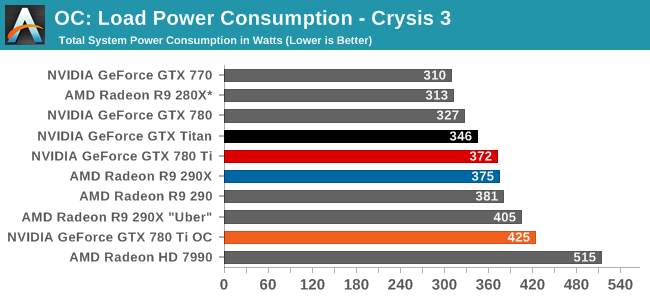
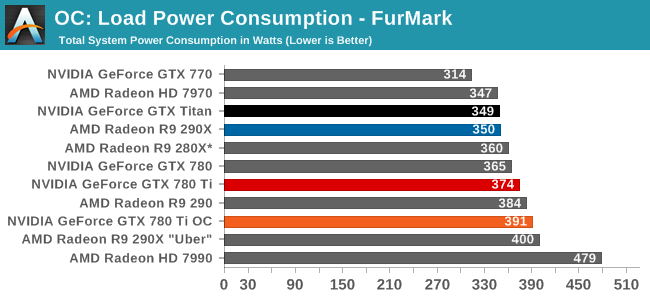
Starting as always with power, temperatures, and noise, we can see that overclocking GTX 780 Ti further increases its power consumption, and to roughly the same degree as what we’ve seen with GTX 780 and GTX Titan in the past. With a maximum TDP of just 106% (265W) the change isn’t so much that the card’s power limit has been significantly lifted – as indicated by FurMark – but rather raising the temperature limit virtually eliminates temperature throttling and as such allows the card to more frequently stay at its highest, most power hungry boost bins.
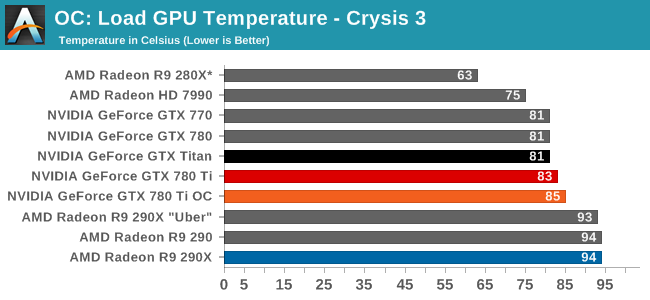

Despite the 95C temperature target we use for overclocking, the GTX 780 Ti finds its new equilibrium point at 85C. The fan will ramp up long before it allows us to get into the 90s.
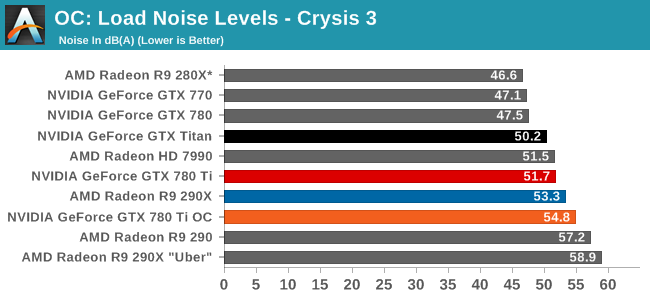
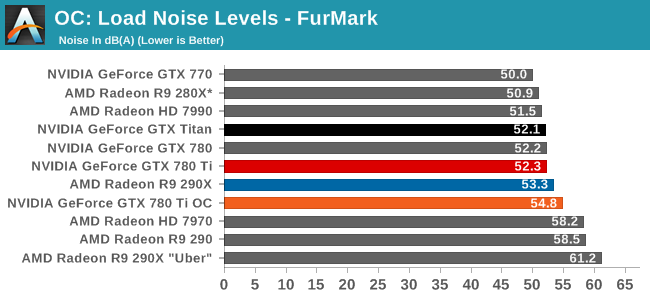
Given the power jump we saw with Crysis 3 the noise ramp up is surprisingly decent. A 3dB rise in noise is going to be noticeable, but even in these overclocked conditions it will avoid being an ear splitting change. To that end overclocking means we’re getting off of GK110’s standard noise efficiency curve just as it does for power, so the cost will almost always outpace the payoff on a relative basis.
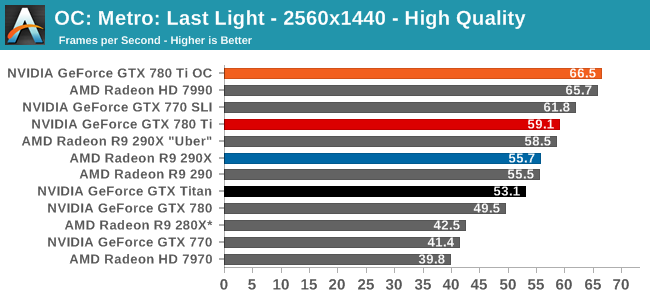
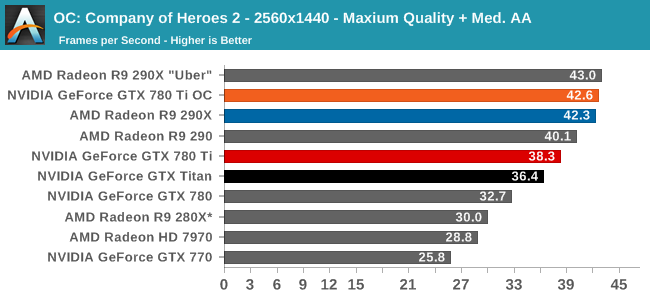
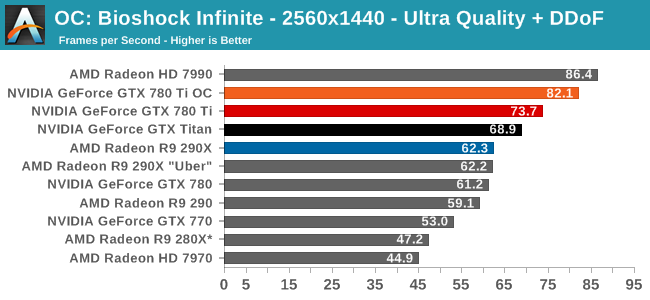
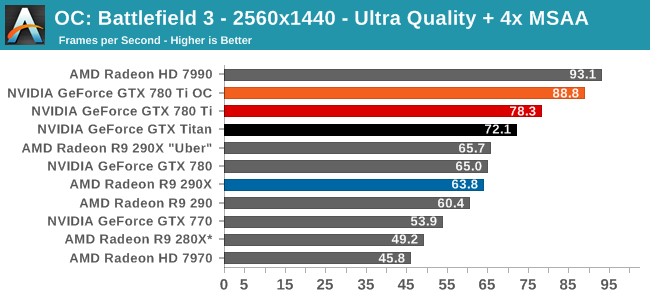
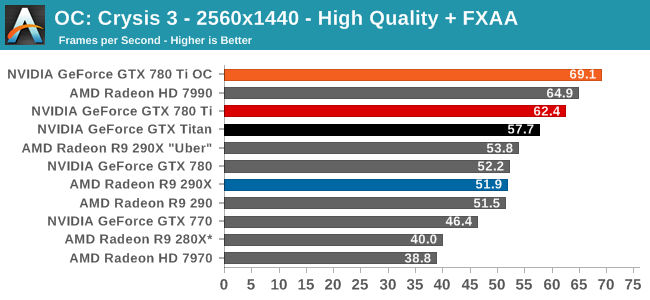
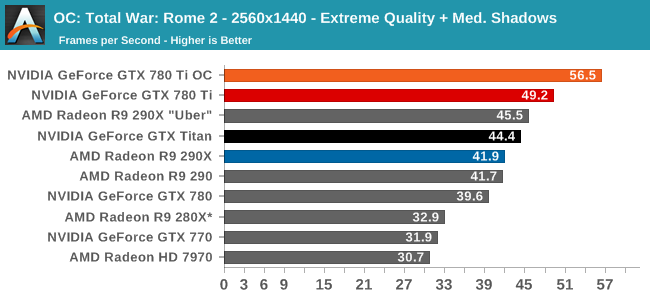
Finally, looking at gaming performance the the overall performance gains for overclocking are generally consistent. Between our 6 games we see a 10-14% performance increase, all in excess of the memory overclock and closely tracking the GPU overclock. GTX 780 Ti is already the fastest single-GPU card, so this only further improves its performance lead. But it does so while cutting into whatever is above it, be it the games where the stock 290X has a lead, or multi-GPU setups such as the 7990.










302 Comments
View All Comments
TheJian - Thursday, November 7, 2013 - link
Not sure you're correct. If NV set 780TI at 95 degrees default how fast would it be going out of the box? 1200mhz-1300mhz (that's 30% free!) judging by Ocing with stock fans already as I noted in the previous post with all the site links and it never goes above 83 doing it. They overclock them and don't hit uber noise. So you can get all the perf from overclocking and SMASH the 290/290x but still be more quiet. I don't call that keeping up. AMD put out a good card, but it has lots of issues (heat/noise and blown away by stock overclocks from NV that won't drive you crazy with noise).From the highest clock I saw so far (1304 at overclockers):
"On the GTX 780 Ti with the fan spinning at 100% locked in a chassis its not bad and will not wake your "neighbors" compared too the R9 290X."
So even at 100% nothing like 290x. :) I call that not competing too ;) How crappy is your fan/heatsink combo if you can't compare to a guy running 100%? Out of the box buyers for ref will be much happier with NV, not to mention all the features they have over AMD and 3 AAA games etc. You release a new card, while your competition just turns on some stuff they've disabled for a year waiting for you to catch them...LOL. On top, your card has "Variance" issues you are admitting you need to fix. You're running so close to crapout, they have been clocked at 669 in QUIET. That's UGLY right? Overclockers got 669 dips on quiet. How usable is that?
Da W - Thursday, November 7, 2013 - link
You done masturbating yet?DMCalloway - Thursday, November 7, 2013 - link
I think you under estimate just how 'happy' early gtx 780 adopters are with current pricing. For what they paid at launch they should've received a fully enabled chip. 7970ghz to r290x is a larger jump forward than gtx 780 to gtx 780Ti. We all remember what happened when AMD pushed their 7970 to the ghz. version in relation to the gtx 680. It's all relative except IMO Nvidia profits more for brand loyalty.Galidou - Thursday, November 7, 2013 - link
If nvidia would have enabled a full chip at 780 launch, imagine titan early adopter... We would have heard their anger far away in space...Margalus - Friday, November 8, 2013 - link
people got exactly what they paid for when they bought it. There is no reason to be upset because a better card is no available.Nevk - Thursday, November 7, 2013 - link
Nvidia fanboyz erererergrayson360 - Thursday, November 7, 2013 - link
Its so sad. I have a 780 and I basically only buy nvidia but that doesn't mean hate the competition. Any competition is good competition :DOverclockedCeleron - Thursday, November 7, 2013 - link
Trolls be damned. 290X = Bulldozer? Really? I am growing sick of these PR reps who troll tech sites. And for the record, a properly-cooled "GHz" edition of the R290X will probably beat GTX 780 Ti in many scenarios and still be over $100 cheaper. Enjoy paying more for less :-).1Angelreloaded - Thursday, November 7, 2013 - link
Probably not in this case, unless the 290x is fitted with a waterblock I don't see it happening. The problem is we will probably see triple slot vapor coolers like HOF galaxy which basically lends to the fact that multi GPU is a non possibility depending on your motherboard. Another thing is I would not put a 290x stock in a 350D or any other itx/matx solution case, between the thermals and the noise of the stock unit. I'm kinda excited for what Hawaii is, but also disappointed that this should have come out during the release of Nvidias 600 series not the end of 700 series cycle.PsiAmp - Thursday, November 7, 2013 - link
tomshardware tested Accelero Xtreme III with R9 290 and it made it nearly silent and very cool. Aslo had better performance.